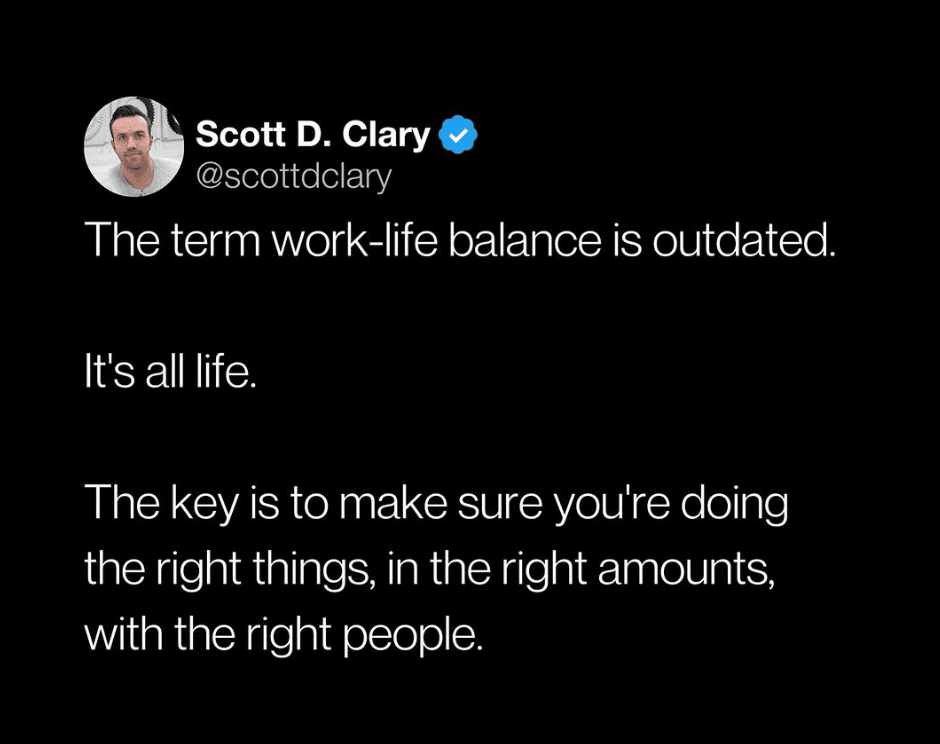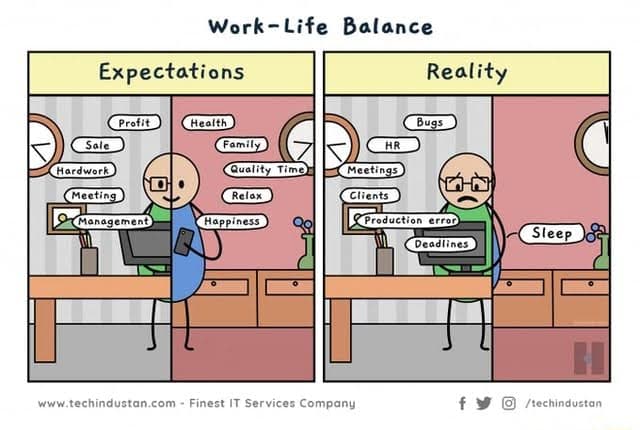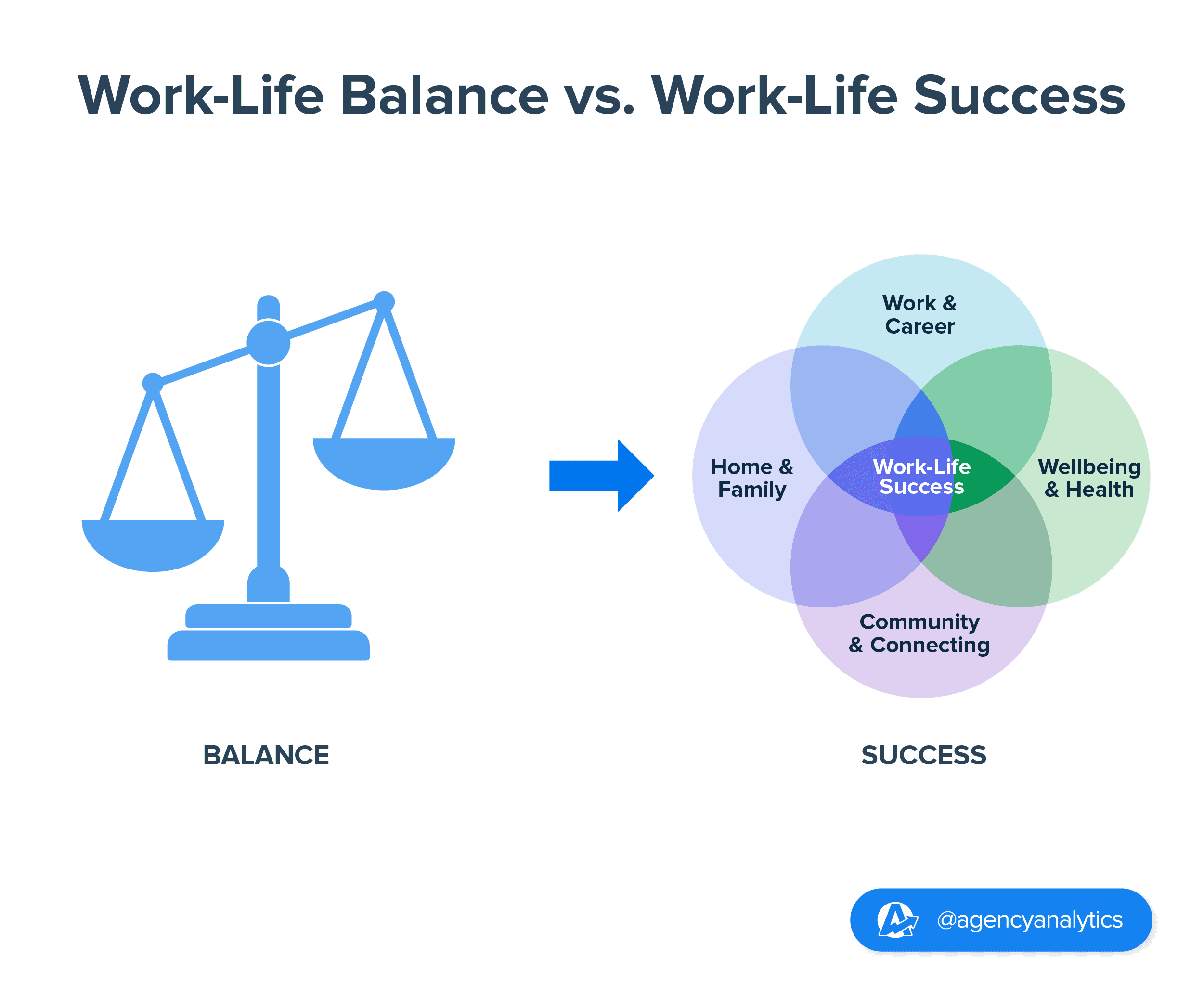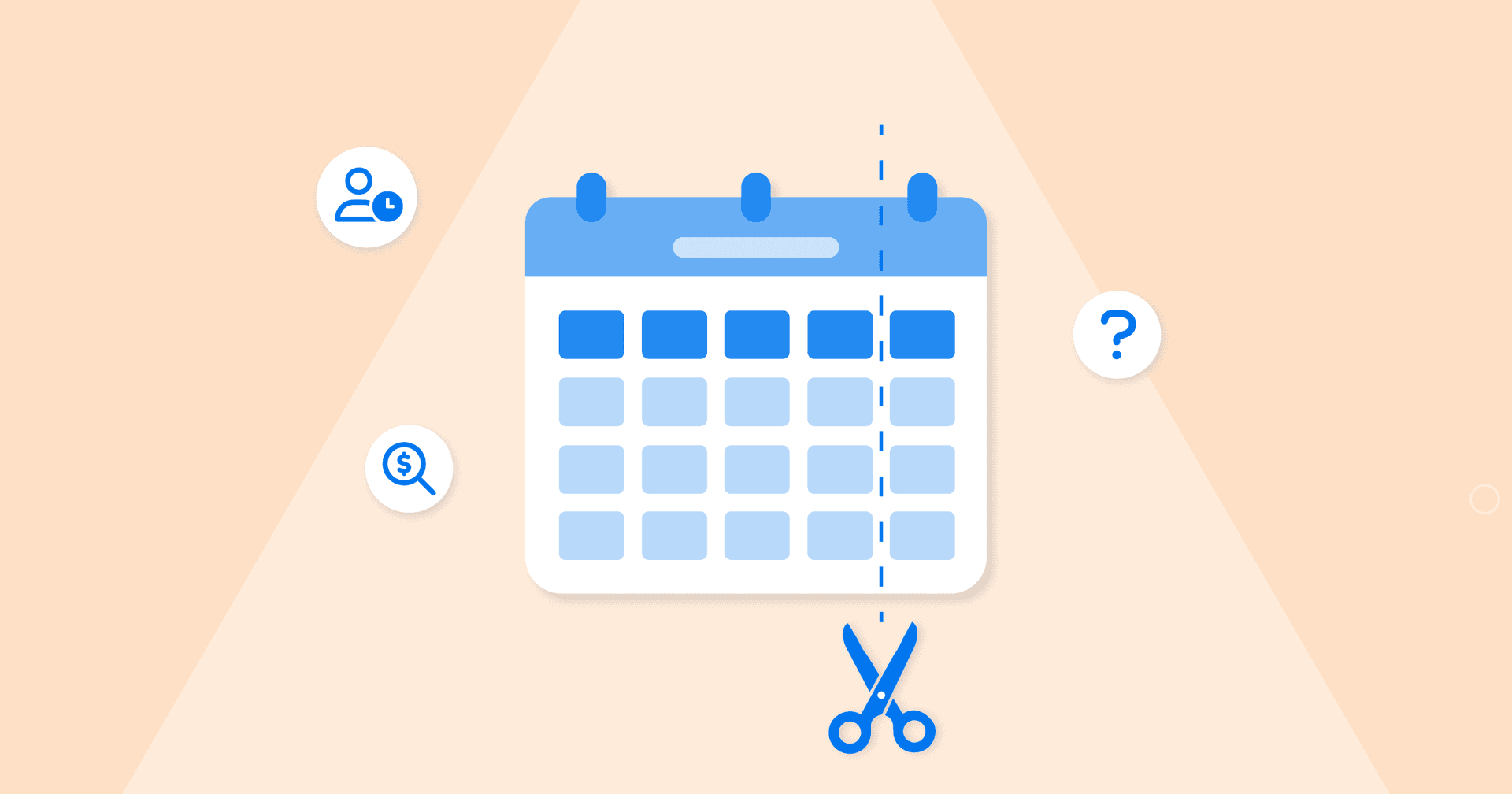Table of Contents
In a world where work and life often blend, especially with many of us working from home, the idea of keeping work and personal life perfectly balanced is outdated.
As Scott D. Clary, Founder and CEO of The Social Club and host of the acclaimed Success Story Podcast, says, “You can’t neatly separate your work from your life. They are intertwined and interdependent.”

Instead of “work-life balance,” there's a growing conversation around “work-life success” or “work-life integration.” This new mode of thinking isn't about dividing your time between work and home. It's about making work fit smoothly into your life in a way that feels right.
For marketing agency leaders, embracing work-life success is crucial.
Work-life success creates an environment where work and personal life support and enhance each other, leading to happier, more fulfilled, and more productive teams.
Let’s discuss how work-life success is potentially a better approach for individuals looking to enjoy their lives more and for leaders who want to build thriving, resilient agencies.
Out Goes the Old Work-Life Balance Model
When we talk about work-life balance, we're referring to dividing our time and energy evenly between work and everything else in our lives.
This concept suggests that achieving a perfect equilibrium between professional responsibilities and personal activities is the key to happiness and success. It's like trying to keep both sides of a scale equally weighted, ensuring that work doesn't overshadow time with family, hobbies, rest, and other personal pursuits.
However, the concept of work-life balance comes with its challenges.
It assumes that everyone's ideal balance looks the same, which isn't true. People have different priorities, responsibilities, and definitions of fulfillment. Also, balance implies a strict separation between work and personal life.

In reality, the boundaries between these areas are often fluid, especially with technology making us accessible around the clock and many people working from home or in flexible arrangements.
Another limitation of striving for work-life balance is that it often creates unnecessary pressure. People might feel like they're failing if they can't achieve this perfect balance, which leads to stress and dissatisfaction.
The balanced mindset must also consider that our needs and priorities change over time.
Sometimes, career demands may require prioritizing work for a period, such as during a project deadline or career advancement opportunity. At other times, personal life events or commitments may take precedence, like doctor’s visit, family gatherings or personal development pursuits.
In trying to maintain an even split between work and personal activities, we might overlook the quality of our engagement in both areas. Being physically present with family or friends means little if you're mentally preoccupied with work.
Similarly, working long hours doesn't guarantee productivity or fulfillment. The balanced approach may lead to a rigid, one-size-fits-all mentality that doesn't fit the dynamic nature of life.
The Drawbacks of a Work-Life Balance Mindset
Drawback | Consequence |
|---|---|
Increasing Work Demands | The pressure to meet the relentless demands of work and the expectation to maintain a separate and equally fulfilling personal life creates an unsustainable cycle of stress and exhaustion, leading to burnout. |
Commute and Travel | For those not working remotely, lengthy commutes eat into personal time, reducing opportunities for relaxation and family engagement. |
Expectations and Deadlines | High expectations and tight deadlines make it nearly impossible to "switch off" after work hours, as the fear of falling behind or underperforming is ever-present. |
Job Insecurity | The fear of job loss compels individuals to prioritize work above all else, often at the expense of health and personal relationships. |
Cultural and Organizational Factors | In environments that glorify overwork, individuals may feel compelled to mirror this behavior to fit in or advance their careers. |
Personal Ambitions and Goals | Ambitious individuals may justify neglecting their personal lives to pursue career success, leading to missed personal milestones and a weakened support network. |
Guilt and Pressure | The guilt of taking personal time and the pressure to compete with peers leads to a diminished sense of self-worth and a constant state of stress. |
Technology and Connectivity | Being constantly connected means work follows individuals everywhere, making it harder to establish clear boundaries between work and personal life. |
Examples of Work-Life Balance Limitations
Let's illustrate the limitations of work-life balance with some examples:
Example 1: The Remote Worker
Imagine John, a marketing specialist who works from home. He tries to adhere to the traditional work-life balance by strictly dividing his day into work hours and personal time. However, this rigid division becomes challenging when personal responsibilities arise, like attending his child's midday school play. Despite completing his tasks efficiently, John struggles with guilt and stress for stepping away from work during traditional hours.
Example 2: The Agency CEO
Sarah, the CEO of a bustling marketing agency, often finds herself inspired with groundbreaking ideas well beyond the traditional 9-5 workday. Attempting to adhere to a strict work-life balance, she forces herself to set these flashes of creativity aside during off-hours, resulting in significant frustration and a palpable sense of missed opportunities. This rigid adherence to conventional work-life boundaries stifles her innovative potential and challenges the practicality of “balance” for someone embedded in the unpredictable rhythm of entrepreneurship.
Example 3: The Business Development Specialist
Linda, a business development specialist, is often faced with a dilemma. Her role requires generating new business opportunities, which means attending networking events like client dinners and cocktail socials outside regular work hours. This puts her in a tough spot: Does she skip these events to enjoy personal time and potentially miss out on valuable opportunities, or attend them and sacrifice time with her family and friends? Despite her commitment to maintaining a balance, she struggles with the feeling that she's either falling short at work or neglecting her personal life.
Example 4: The Solopreneur
As a solopreneur, Mark faces the "feast or famine" reality of freelance life. There are moments when work pours in, requiring him to put in long hours to meet tight deadlines. During these times, achieving a traditional work-life balance feels nearly impossible. Mark often feels inadequate for not maintaining a better balance, even though he knows that these intense work periods will be followed by "famine" phases when he can slow down and focus on personal pursuits.
These examples highlight the need for a more flexible, nuanced approach that allows individuals to integrate work and personal life in a way that aligns with their unique circumstances, priorities, and rhythms.
In Comes the New Work-Life Success Approach
Work-life balance suggests a static solution to a dynamic challenge, often leading to frustration rather than fulfillment. This realization brings us to work-life success, a more flexible and personalized approach that acknowledges the intertwined nature of work and personal life.
Work-life success (or work-life integration) isn’t just a new buzzword to toss around in board meetings or team catch-ups; it's a paradigm shift that redefines how we integrate our professional ambitions with our personal fulfillment.
As leaders in agency marketing, it’s crucial to champion this mindset for ourselves, the teams we lead, and the cultures we foster.
What Is Work-Life Success?
Work-life success transcends the traditional work-life balance boundaries by focusing on outcomes rather than a strict division of time. It's about creating an environment where our work fuels our passion, and our personal life enriches our creativity and innovation.
With this approach, we recognize that success is deeply personal and varies from one individual to another. With it comes the acknowledgment that there are times when caring for your sick toddler takes priority over work, which can wait until later in the day. The flexibility to make that choice is inherent in work-life success.
It's not about how many hours you log off from work or the quantity of personal time you clock in; it's about the quality of your engagement in both areas and how they contribute to your overall sense of achievement and happiness.

The critical difference between work-life balance and work-life success lies in flexibility and personalization.
While work-life balance attempts to create an equal partition between work and personal life, work-life success recognizes that the value comes from how these aspects interact and enhance each other.
The Benefits of Embracing Work-Life Success
It's essential for us, as leaders, to recognize the transformative impact a work-life success approach will have on our teams, our organizations, and ourselves.
At AgencyAnalytics, we frequently discuss work-life balance/success, employee and client satisfaction, and productivity with over 7,000 marketing agency clients using our reporting solution. Their insights and personal experiences helped us define the benefits of embracing work-life success outlined below.
Enhanced Well-Being and Reduced Burnout
The first—and perhaps most critical—benefit of adopting work-life success is the significant improvement in overall well-being it brings to our teams. Allowing individuals the flexibility to weave their work around their life's passions, interests, and responsibilities enables them to mitigate stress and reduce the risk of burnout.
This approach acknowledges that well-rested, mentally healthy employees are more engaged, creative, and productive. It's about creating an environment where work feels less like an obligation and more like a meaningful part of a well-rounded life.
Marketing is about delivering the best possible work for every client, and that can't happen when staff are tired or burned out. Tired minds aren't creative. Energized minds are primed for innovation. After all, isn't exceptional work what our clients deserve?
Michelle van Blerck, Communications Manager, Digital Freak
Increased Productivity and Creativity
Work-life success fosters an environment where creativity and productivity flourish. When individuals are empowered to work in ways that best suit their rhythms and life circumstances, they're more likely to bring their best selves to their work.
For example, allowing a developer to work from a quiet, inspiring location or letting a designer choose their working hours may lead to breakthrough ideas and innovations.
At AgencyAnalytics, we allow five months of work outside the country per year, which empowers our team members to travel and explore. This year, our PPC Manager spent two months in Spain while working on various projects, and our Director of Content and SEO worked for six weeks while spending time in Florida. This flexibility results in higher-quality work, as employees are not just present but fully engaged and motivated by a sense of personal fulfillment.
Your staff are at the heart of the great marketing work you produce. The happier, healthier, and more valued they feel, the more engaged, excited, and hungry they'll be to deliver their best.
Michelle van Blerck, Communications Manager, Digital Freak
Attraction and Retention of Top Talent
In today's job market, especially within the tech and creative industries, attracting and retaining top talent is a critical competitive advantage. Millennials and Gen Z workers, in particular, prioritize flexibility, purpose, and well-being in their career choices.
By championing work-life success, we position our organizations as forward-thinking, employee-centric places to work. This reputation makes us more attractive to ambitious, high-caliber professionals looking for roles supporting their overall life goals, not just their career ambitions.
We place a huge emphasis on people and relationships. We attract high-quality talent by offering competitive salaries, great personal and professional advancement opportunities, and amazing benefits. By focusing so much on the happiness of each individual employee, we ensure better outcomes for our clients as well. We know this people-first strategy works because our employee and client retention rate is incredibly high.
Graham Lumley, Director of Marketing, Blackhawk Digital Marketing
A Positive Organizational Culture
Embracing work-life success transforms organizational culture. It shifts the narrative from mere work-life balance—a somewhat transactional approach—to one where personal and professional growth are intertwined.
This cultural shift creates a more supportive, understanding, and collaborative workplace. It fosters a sense of community and belonging, where employees feel valued not just for their work output but as individuals.
In our agency, employee engagement is deeply rooted in our core values of balance, knowledge, commitment, and growth. Their dedication drives exceptional results for our clients and fosters an environment of collective growth and innovation.
Tharindu Gunawardana, SEO Director, Sentius Digital
Leading by Example
As leaders, embracing work-life success sets a powerful example for our teams.
Sharing our experiences of integrating work with our passions or how we navigate challenges fosters a culture of openness and trust. It encourages others to find their paths to work-life success, reinforcing that success is a personalized journey.
There are some nights where a team member has to work late, but I really try to minimize that. I try to give the team their weekends. We have an unlimited vacation policy, and we take every holiday that there is to take off on the calendar. We try to have a three-day weekend at least once a month and make sure everyone keeps that perspective. Because the reality is that this job is not their life, this company is not their life.
Molly Lopez, Franchise Owner, HITE Digital
Work-Life Success Scenarios
Work-life success will manifest in diverse and meaningful ways for individuals. Here are some examples illustrating how different people might experience and achieve work-life success:
Scenario 1: The Creative Director
Emma, a creative director at a bustling marketing agency, finds her work-life success in the flexibility to start her day later in the morning. This adjustment allows her to spend mornings with her young children, engaging in creative play that inspires her work. Her agency values outcomes over hours at the desk, so Emma often works from different locations, including cafes and parks, to stimulate her creativity. For Emma, work-life success means integrating her family time and work in a way that enhances her creative output and personal satisfaction.
Scenario 2: The Agency Startup Founder
Alex, who founded an agency startup, thrives on the autonomy to blend work with his passion for outdoor adventures. He schedules strategic business thinking and team meetings around hiking trips, believing the best ideas come when he's physically active and connected with nature. This approach keeps Alex mentally and physically healthy and instills a culture of wellness and creativity within his startup, aligning work with his values of health and innovation.
Scenario 3: The Freelance Consultant
Priya is a freelance marketing consultant who values the autonomy to choose projects that align with her interests in sustainable and ethical businesses. Her work-life success comes from the ability to travel and work simultaneously, exploring new cultures and ideas that inform her consulting practice. For Priya, aligning work with her personal goals and values is paramount, and her flexible lifestyle enables her to pursue projects that have a meaningful impact on the world.
Scenario 4: The Agency Exec
David, an executive in a leading agency, achieves work-life success through a structured approach to flexibility. He dedicates specific hours to uninterrupted work, allowing him to focus intensely on strategic initiatives. Outside these hours, he is committed to personal development activities, such as mentoring young entrepreneurs and pursuing an executive education program. This structured flexibility allows David to excel in his role while fulfilling his aspirations for growth and giving back to the community.
What unites these stories is the emphasis on flexibility, autonomy, and the importance of aligning work with personal values and goals.
How To Implement Work-Life Success Strategies
Fostering a culture of work-life success within our organizations requires intentional actions and policies.
Here are some practical strategies to implement work-life success in your agency:
Flexible Working Arrangements
Embrace Flexibility: Offer a variety of working arrangements, such as remote work options, flexible hours, and compressed work weeks. For example, AgencyAnalytics allows employees to work five months outside of the country every year. This flexibility allows employees to work when they are most productive and balance their personal commitments, enhancing satisfaction and efficiency.
Customize Work Models: Recognize that one size does not fit all. Encourage team leaders to work with their members to find the best working arrangements that suit individual and team needs, promoting autonomy and trust.
Encourage Time Off
Promote Time Off: Actively encourage employees to take vacation and regular daily breaks. Emphasize the importance of rest and disconnection for long-term productivity and creativity.
Model the Behavior: Lead by example by taking time off and sharing your experiences. This sets a precedent in the organization that taking time for oneself is accepted and encouraged.
The true measure of success came this summer when I noticed that every employee had taken their vacation time—a testament to the culture of wellness we've cultivated. This shift didn't just happen overnight. It required a conscious effort to align my actions with my advocacy for wellness, demonstrating that managing stress is not only crucial for our well-being but also enhances our work performance.
Jessica Tappana, Founder, Simplified SEO Consulting
Supporting Personal Development Goals
Invest in Growth: Provide resources and opportunities for employees to pursue personal and professional development goals. This could include access to courses, workshops, mentorship programs, or even time off for individual projects.
Personal Goal Alignment: Help employees align their personal goals with their professional work. Encouraging this alignment shows that you value their growth and well-being beyond their job performance.
Set Clear Expectations
Define Success: Clearly articulate what success looks like for each role, focusing on outcomes rather than hours spent working. This clarity helps employees manage their time effectively and meet expectations in a way that aligns with their work-life integration.
Transparent Communication: Maintain open lines of communication about organizational goals, team objectives, and individual expectations. This transparency helps align efforts and reduces uncertainty and stress.
Provide Resources for Mental Health and Well-Being
Well-Being Programs: Implement and promote well-being programs that support mental health, such as counseling services, stress management workshops, and wellness apps.
Safe Space for Conversations: Foster an environment where employees feel comfortable discussing their well-being and any support they may need. This openness can help address potential issues before they become serious.
Continuous Dialogue and Feedback
Regular Check-Ins: Hold regular one-on-one meetings with team members to discuss their work-life integration, challenges, and successes. These conversations can provide valuable insights into how to support individual and team success further.
Feedback Loops: Create mechanisms for employees to provide feedback on work-life integration policies and practices. Use this feedback to refine and adapt strategies, showing that you value their input and are committed to continuous improvement.
Implementing these strategies requires a commitment from the top down to redefine success in our organizations. By fostering a work-life success culture, we enhance our teams' well-being and satisfaction and drive innovation, productivity, and resilience in our organizations.
Moving Beyond the Balancing Act to a Success-Driven Approach
Work-life success, emphasizing flexibility, autonomy, and integrating personal values and professional aspirations, emerges as a more adaptable and beneficial strategy than the rigid pursuit of balance.
As leaders in marketing and beyond, we are responsible for championing this shift towards work-life success. It's not just about adopting new policies or practices; it's about reimagining what success looks like for our teams and ourselves. Leading by example and creating spaces for open dialogue and continuous improvement will help us build successful organizations and foster the well-being and fulfillment of everyone involved.
Achieving work-life success requires ongoing evaluation and adjustment as circumstances change. This adaptive approach ensures that individuals remain satisfied with their life choices over time. I encourage all leaders to rethink their strategies for integrating work and personal life. Consider how adopting a work-life success mindset could benefit you and your organization. Let's strive to create environments where work and life are not in competition but in harmony, supporting our collective growth.

Written by
Jacob is an entrepreneurial and hands-on senior B2B SaaS marketing and sales executive with over 15 years of related experience with startups and scaleups. He builds data-driven centers of excellence in revenue operations that result in consistent growth in revenue (ARR) and customers.
Read more posts by Jacob VargheseSee how 7,000+ marketing agencies help clients win
Free 14-day trial. No credit card required.






